Business Functions and Competitive Environment: A Comprehensive Report
VerifiedAdded on 2023/01/04
|10
|2622
|36
Report
AI Summary
This report provides a comprehensive analysis of business functions within a competitive environment. It begins by describing functional organizational structures, professional ethics, and the need for equality within the UK business environment. The report then delves into accounting documents required for audits and statutory audit requirements. The relationship between business functions and financial systems is examined, highlighting the dangers of exceeding budgets. Finally, the report emphasizes the importance of effective teamwork for achieving team and business growth and success, concluding with a summary of the key findings and implications for business operations.
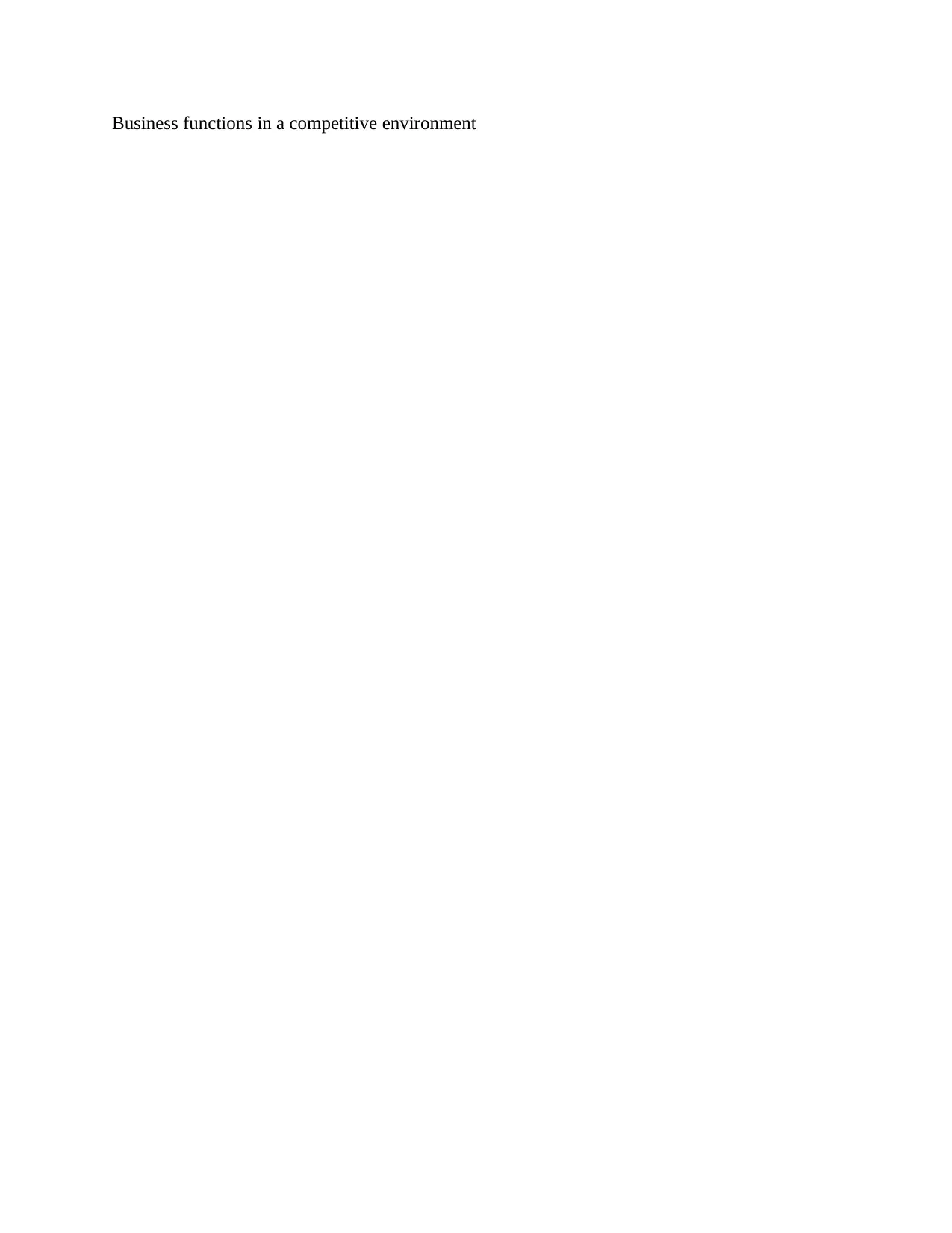
Business functions in a competitive environment
Paraphrase This Document
Need a fresh take? Get an instant paraphrase of this document with our AI Paraphraser
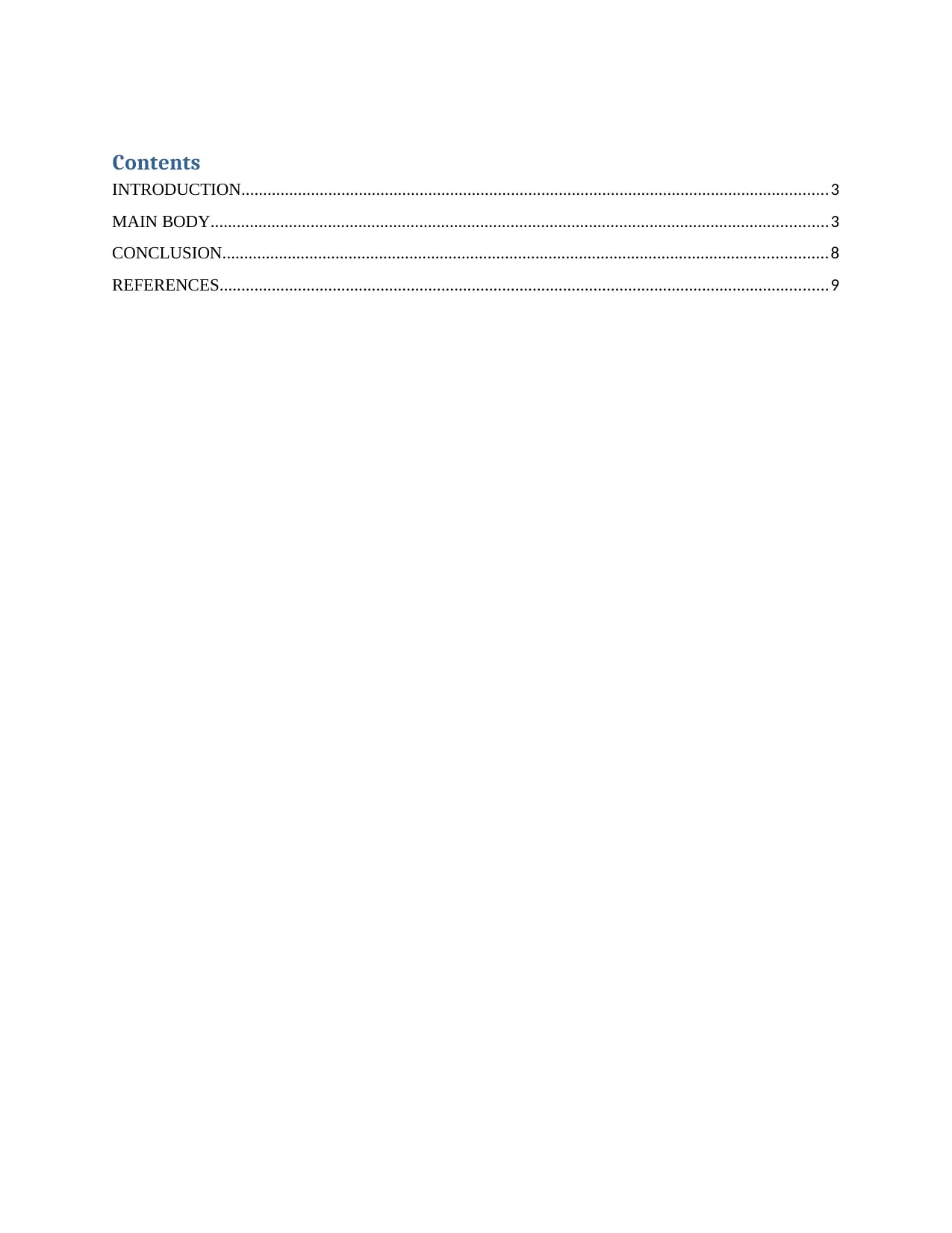
Contents
INTRODUCTION.......................................................................................................................................3
MAIN BODY..............................................................................................................................................3
CONCLUSION...........................................................................................................................................8
REFERENCES............................................................................................................................................9
INTRODUCTION.......................................................................................................................................3
MAIN BODY..............................................................................................................................................3
CONCLUSION...........................................................................................................................................8
REFERENCES............................................................................................................................................9
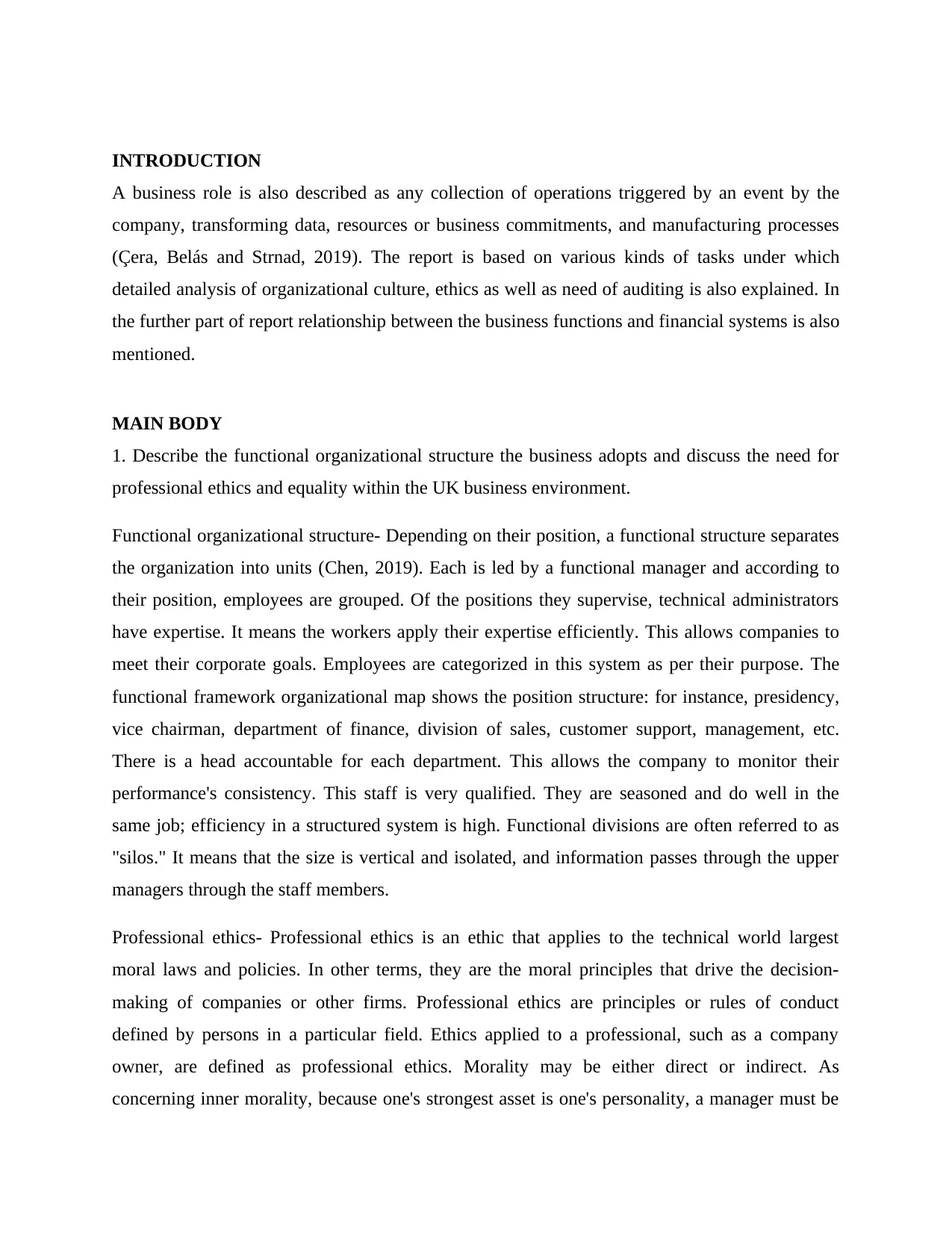
INTRODUCTION
A business role is also described as any collection of operations triggered by an event by the
company, transforming data, resources or business commitments, and manufacturing processes
(Çera, Belás and Strnad, 2019). The report is based on various kinds of tasks under which
detailed analysis of organizational culture, ethics as well as need of auditing is also explained. In
the further part of report relationship between the business functions and financial systems is also
mentioned.
MAIN BODY
1. Describe the functional organizational structure the business adopts and discuss the need for
professional ethics and equality within the UK business environment.
Functional organizational structure- Depending on their position, a functional structure separates
the organization into units (Chen, 2019). Each is led by a functional manager and according to
their position, employees are grouped. Of the positions they supervise, technical administrators
have expertise. It means the workers apply their expertise efficiently. This allows companies to
meet their corporate goals. Employees are categorized in this system as per their purpose. The
functional framework organizational map shows the position structure: for instance, presidency,
vice chairman, department of finance, division of sales, customer support, management, etc.
There is a head accountable for each department. This allows the company to monitor their
performance's consistency. This staff is very qualified. They are seasoned and do well in the
same job; efficiency in a structured system is high. Functional divisions are often referred to as
"silos." It means that the size is vertical and isolated, and information passes through the upper
managers through the staff members.
Professional ethics- Professional ethics is an ethic that applies to the technical world largest
moral laws and policies. In other terms, they are the moral principles that drive the decision-
making of companies or other firms. Professional ethics are principles or rules of conduct
defined by persons in a particular field. Ethics applied to a professional, such as a company
owner, are defined as professional ethics. Morality may be either direct or indirect. As
concerning inner morality, because one's strongest asset is one's personality, a manager must be
A business role is also described as any collection of operations triggered by an event by the
company, transforming data, resources or business commitments, and manufacturing processes
(Çera, Belás and Strnad, 2019). The report is based on various kinds of tasks under which
detailed analysis of organizational culture, ethics as well as need of auditing is also explained. In
the further part of report relationship between the business functions and financial systems is also
mentioned.
MAIN BODY
1. Describe the functional organizational structure the business adopts and discuss the need for
professional ethics and equality within the UK business environment.
Functional organizational structure- Depending on their position, a functional structure separates
the organization into units (Chen, 2019). Each is led by a functional manager and according to
their position, employees are grouped. Of the positions they supervise, technical administrators
have expertise. It means the workers apply their expertise efficiently. This allows companies to
meet their corporate goals. Employees are categorized in this system as per their purpose. The
functional framework organizational map shows the position structure: for instance, presidency,
vice chairman, department of finance, division of sales, customer support, management, etc.
There is a head accountable for each department. This allows the company to monitor their
performance's consistency. This staff is very qualified. They are seasoned and do well in the
same job; efficiency in a structured system is high. Functional divisions are often referred to as
"silos." It means that the size is vertical and isolated, and information passes through the upper
managers through the staff members.
Professional ethics- Professional ethics is an ethic that applies to the technical world largest
moral laws and policies. In other terms, they are the moral principles that drive the decision-
making of companies or other firms. Professional ethics are principles or rules of conduct
defined by persons in a particular field. Ethics applied to a professional, such as a company
owner, are defined as professional ethics. Morality may be either direct or indirect. As
concerning inner morality, because one's strongest asset is one's personality, a manager must be
⊘ This is a preview!⊘
Do you want full access?
Subscribe today to unlock all pages.

Trusted by 1+ million students worldwide
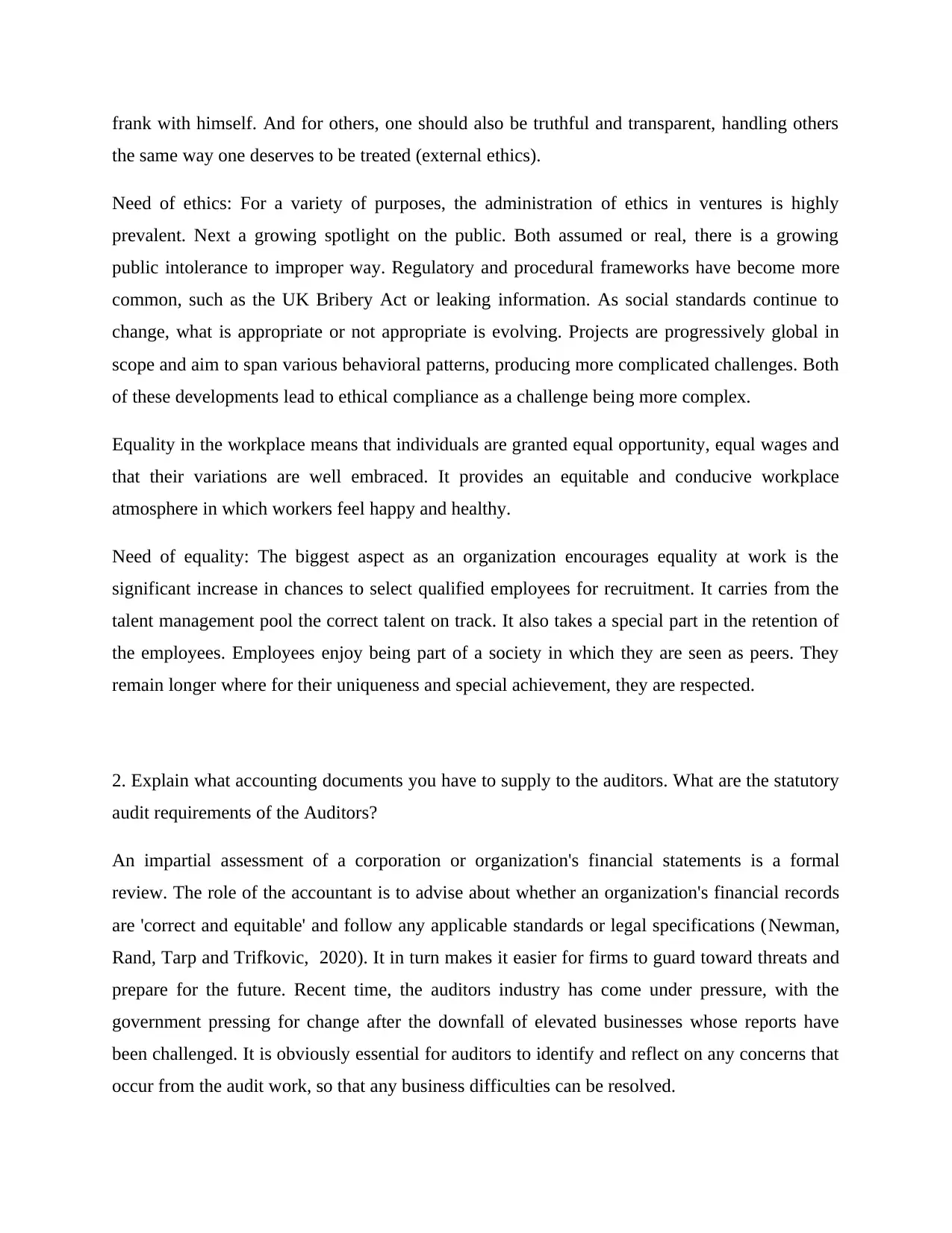
frank with himself. And for others, one should also be truthful and transparent, handling others
the same way one deserves to be treated (external ethics).
Need of ethics: For a variety of purposes, the administration of ethics in ventures is highly
prevalent. Next a growing spotlight on the public. Both assumed or real, there is a growing
public intolerance to improper way. Regulatory and procedural frameworks have become more
common, such as the UK Bribery Act or leaking information. As social standards continue to
change, what is appropriate or not appropriate is evolving. Projects are progressively global in
scope and aim to span various behavioral patterns, producing more complicated challenges. Both
of these developments lead to ethical compliance as a challenge being more complex.
Equality in the workplace means that individuals are granted equal opportunity, equal wages and
that their variations are well embraced. It provides an equitable and conducive workplace
atmosphere in which workers feel happy and healthy.
Need of equality: The biggest aspect as an organization encourages equality at work is the
significant increase in chances to select qualified employees for recruitment. It carries from the
talent management pool the correct talent on track. It also takes a special part in the retention of
the employees. Employees enjoy being part of a society in which they are seen as peers. They
remain longer where for their uniqueness and special achievement, they are respected.
2. Explain what accounting documents you have to supply to the auditors. What are the statutory
audit requirements of the Auditors?
An impartial assessment of a corporation or organization's financial statements is a formal
review. The role of the accountant is to advise about whether an organization's financial records
are 'correct and equitable' and follow any applicable standards or legal specifications (Newman,
Rand, Tarp and Trifkovic, 2020). It in turn makes it easier for firms to guard toward threats and
prepare for the future. Recent time, the auditors industry has come under pressure, with the
government pressing for change after the downfall of elevated businesses whose reports have
been challenged. It is obviously essential for auditors to identify and reflect on any concerns that
occur from the audit work, so that any business difficulties can be resolved.
the same way one deserves to be treated (external ethics).
Need of ethics: For a variety of purposes, the administration of ethics in ventures is highly
prevalent. Next a growing spotlight on the public. Both assumed or real, there is a growing
public intolerance to improper way. Regulatory and procedural frameworks have become more
common, such as the UK Bribery Act or leaking information. As social standards continue to
change, what is appropriate or not appropriate is evolving. Projects are progressively global in
scope and aim to span various behavioral patterns, producing more complicated challenges. Both
of these developments lead to ethical compliance as a challenge being more complex.
Equality in the workplace means that individuals are granted equal opportunity, equal wages and
that their variations are well embraced. It provides an equitable and conducive workplace
atmosphere in which workers feel happy and healthy.
Need of equality: The biggest aspect as an organization encourages equality at work is the
significant increase in chances to select qualified employees for recruitment. It carries from the
talent management pool the correct talent on track. It also takes a special part in the retention of
the employees. Employees enjoy being part of a society in which they are seen as peers. They
remain longer where for their uniqueness and special achievement, they are respected.
2. Explain what accounting documents you have to supply to the auditors. What are the statutory
audit requirements of the Auditors?
An impartial assessment of a corporation or organization's financial statements is a formal
review. The role of the accountant is to advise about whether an organization's financial records
are 'correct and equitable' and follow any applicable standards or legal specifications (Newman,
Rand, Tarp and Trifkovic, 2020). It in turn makes it easier for firms to guard toward threats and
prepare for the future. Recent time, the auditors industry has come under pressure, with the
government pressing for change after the downfall of elevated businesses whose reports have
been challenged. It is obviously essential for auditors to identify and reflect on any concerns that
occur from the audit work, so that any business difficulties can be resolved.
Paraphrase This Document
Need a fresh take? Get an instant paraphrase of this document with our AI Paraphraser
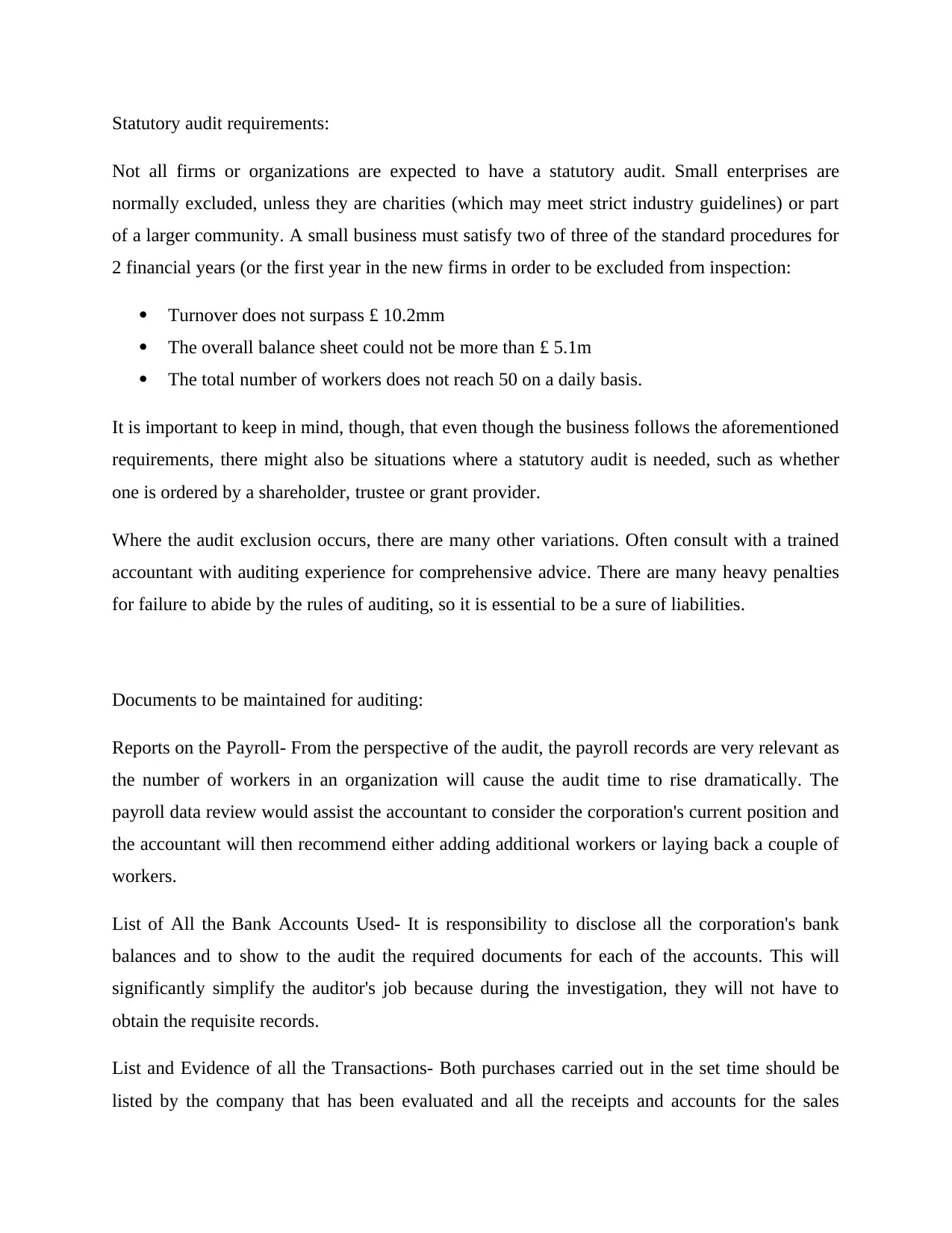
Statutory audit requirements:
Not all firms or organizations are expected to have a statutory audit. Small enterprises are
normally excluded, unless they are charities (which may meet strict industry guidelines) or part
of a larger community. A small business must satisfy two of three of the standard procedures for
2 financial years (or the first year in the new firms in order to be excluded from inspection:
Turnover does not surpass £ 10.2mm
The overall balance sheet could not be more than £ 5.1m
The total number of workers does not reach 50 on a daily basis.
It is important to keep in mind, though, that even though the business follows the aforementioned
requirements, there might also be situations where a statutory audit is needed, such as whether
one is ordered by a shareholder, trustee or grant provider.
Where the audit exclusion occurs, there are many other variations. Often consult with a trained
accountant with auditing experience for comprehensive advice. There are many heavy penalties
for failure to abide by the rules of auditing, so it is essential to be a sure of liabilities.
Documents to be maintained for auditing:
Reports on the Payroll- From the perspective of the audit, the payroll records are very relevant as
the number of workers in an organization will cause the audit time to rise dramatically. The
payroll data review would assist the accountant to consider the corporation's current position and
the accountant will then recommend either adding additional workers or laying back a couple of
workers.
List of All the Bank Accounts Used- It is responsibility to disclose all the corporation's bank
balances and to show to the audit the required documents for each of the accounts. This will
significantly simplify the auditor's job because during the investigation, they will not have to
obtain the requisite records.
List and Evidence of all the Transactions- Both purchases carried out in the set time should be
listed by the company that has been evaluated and all the receipts and accounts for the sales
Not all firms or organizations are expected to have a statutory audit. Small enterprises are
normally excluded, unless they are charities (which may meet strict industry guidelines) or part
of a larger community. A small business must satisfy two of three of the standard procedures for
2 financial years (or the first year in the new firms in order to be excluded from inspection:
Turnover does not surpass £ 10.2mm
The overall balance sheet could not be more than £ 5.1m
The total number of workers does not reach 50 on a daily basis.
It is important to keep in mind, though, that even though the business follows the aforementioned
requirements, there might also be situations where a statutory audit is needed, such as whether
one is ordered by a shareholder, trustee or grant provider.
Where the audit exclusion occurs, there are many other variations. Often consult with a trained
accountant with auditing experience for comprehensive advice. There are many heavy penalties
for failure to abide by the rules of auditing, so it is essential to be a sure of liabilities.
Documents to be maintained for auditing:
Reports on the Payroll- From the perspective of the audit, the payroll records are very relevant as
the number of workers in an organization will cause the audit time to rise dramatically. The
payroll data review would assist the accountant to consider the corporation's current position and
the accountant will then recommend either adding additional workers or laying back a couple of
workers.
List of All the Bank Accounts Used- It is responsibility to disclose all the corporation's bank
balances and to show to the audit the required documents for each of the accounts. This will
significantly simplify the auditor's job because during the investigation, they will not have to
obtain the requisite records.
List and Evidence of all the Transactions- Both purchases carried out in the set time should be
listed by the company that has been evaluated and all the receipts and accounts for the sales
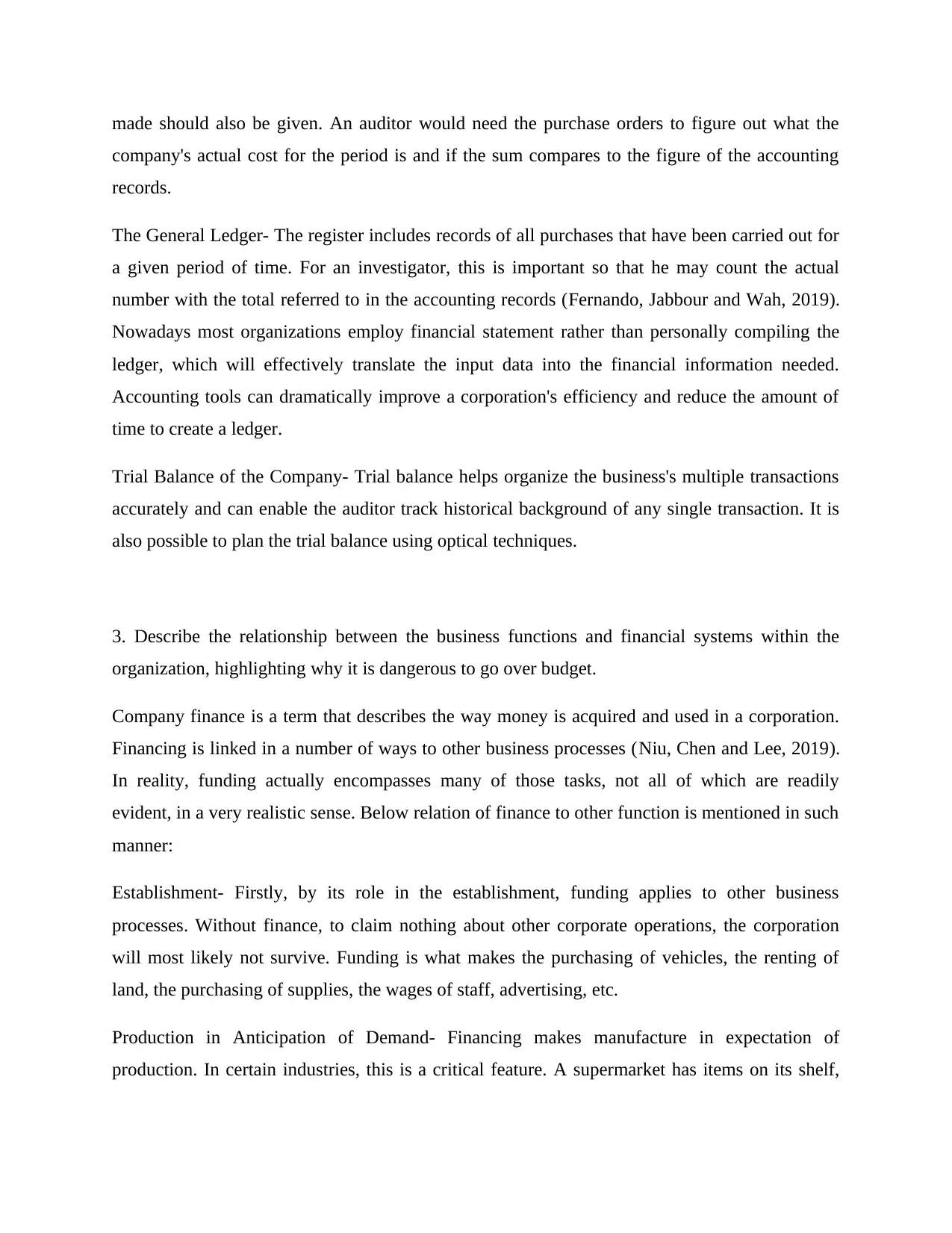
made should also be given. An auditor would need the purchase orders to figure out what the
company's actual cost for the period is and if the sum compares to the figure of the accounting
records.
The General Ledger- The register includes records of all purchases that have been carried out for
a given period of time. For an investigator, this is important so that he may count the actual
number with the total referred to in the accounting records (Fernando, Jabbour and Wah, 2019).
Nowadays most organizations employ financial statement rather than personally compiling the
ledger, which will effectively translate the input data into the financial information needed.
Accounting tools can dramatically improve a corporation's efficiency and reduce the amount of
time to create a ledger.
Trial Balance of the Company- Trial balance helps organize the business's multiple transactions
accurately and can enable the auditor track historical background of any single transaction. It is
also possible to plan the trial balance using optical techniques.
3. Describe the relationship between the business functions and financial systems within the
organization, highlighting why it is dangerous to go over budget.
Company finance is a term that describes the way money is acquired and used in a corporation.
Financing is linked in a number of ways to other business processes (Niu, Chen and Lee, 2019).
In reality, funding actually encompasses many of those tasks, not all of which are readily
evident, in a very realistic sense. Below relation of finance to other function is mentioned in such
manner:
Establishment- Firstly, by its role in the establishment, funding applies to other business
processes. Without finance, to claim nothing about other corporate operations, the corporation
will most likely not survive. Funding is what makes the purchasing of vehicles, the renting of
land, the purchasing of supplies, the wages of staff, advertising, etc.
Production in Anticipation of Demand- Financing makes manufacture in expectation of
production. In certain industries, this is a critical feature. A supermarket has items on its shelf,
company's actual cost for the period is and if the sum compares to the figure of the accounting
records.
The General Ledger- The register includes records of all purchases that have been carried out for
a given period of time. For an investigator, this is important so that he may count the actual
number with the total referred to in the accounting records (Fernando, Jabbour and Wah, 2019).
Nowadays most organizations employ financial statement rather than personally compiling the
ledger, which will effectively translate the input data into the financial information needed.
Accounting tools can dramatically improve a corporation's efficiency and reduce the amount of
time to create a ledger.
Trial Balance of the Company- Trial balance helps organize the business's multiple transactions
accurately and can enable the auditor track historical background of any single transaction. It is
also possible to plan the trial balance using optical techniques.
3. Describe the relationship between the business functions and financial systems within the
organization, highlighting why it is dangerous to go over budget.
Company finance is a term that describes the way money is acquired and used in a corporation.
Financing is linked in a number of ways to other business processes (Niu, Chen and Lee, 2019).
In reality, funding actually encompasses many of those tasks, not all of which are readily
evident, in a very realistic sense. Below relation of finance to other function is mentioned in such
manner:
Establishment- Firstly, by its role in the establishment, funding applies to other business
processes. Without finance, to claim nothing about other corporate operations, the corporation
will most likely not survive. Funding is what makes the purchasing of vehicles, the renting of
land, the purchasing of supplies, the wages of staff, advertising, etc.
Production in Anticipation of Demand- Financing makes manufacture in expectation of
production. In certain industries, this is a critical feature. A supermarket has items on its shelf,
⊘ This is a preview!⊘
Do you want full access?
Subscribe today to unlock all pages.

Trusted by 1+ million students worldwide

for instance, not just a storefront of catalogues. Similarly, a carpenter does not wait until he has a
project to purchase its instruments.
Promotion- Financing provides for marketing, too. The marketing of a corporation is a costly
undertaking, spending about as much as the expense of products sold or staffing in some
situations. In order to finance the advertisement, financing is needed. If it does not promote its
existence, its product/service services and its pricing structure, an organization would not get
many clients (e.g. low price, great value, special features).
Growth- Financing also plays a significant role in a firm's expansion. Without advanced requests
and fees, growth with funding will not be an option (Li, Liu and Zhou, 2020). Business
development is followed in most instances by expenditure in additional workers, more stock,
more place, etc.
Contingencies- Adequate finance therefore assures that any contingency plans that occur will be
managed by the firm. Some type of unforeseen cost is a risk. Because such, scenarios range from
broken pipes to a purchasing error causing rush distribution to alter to hiring a substitute
employee to replace someone with an extended holiday from of the work. Something might
happen, but the firm will not be able to purchase this without capital.
Opportunities- Finally, funding provides for prospects that can occur at any moment. A business
cannot reap the benefits of those possibilities without funding. For example, if the main widget
provider of the company runs out of money and liquidates the stock, if the firm has access to
money, it will be able to buy the widgets it wants at a drastically discounted rate, raising its
profitability.
Why it is dangerous to go over budget: This is very risky when a company goes over budget.
This is so because if a company fails to maintain expenses below budgeted amount that it can be
stated that company is unable to manage their expenses in an effective manner (Popescu and
Popescu, 2019).
project to purchase its instruments.
Promotion- Financing provides for marketing, too. The marketing of a corporation is a costly
undertaking, spending about as much as the expense of products sold or staffing in some
situations. In order to finance the advertisement, financing is needed. If it does not promote its
existence, its product/service services and its pricing structure, an organization would not get
many clients (e.g. low price, great value, special features).
Growth- Financing also plays a significant role in a firm's expansion. Without advanced requests
and fees, growth with funding will not be an option (Li, Liu and Zhou, 2020). Business
development is followed in most instances by expenditure in additional workers, more stock,
more place, etc.
Contingencies- Adequate finance therefore assures that any contingency plans that occur will be
managed by the firm. Some type of unforeseen cost is a risk. Because such, scenarios range from
broken pipes to a purchasing error causing rush distribution to alter to hiring a substitute
employee to replace someone with an extended holiday from of the work. Something might
happen, but the firm will not be able to purchase this without capital.
Opportunities- Finally, funding provides for prospects that can occur at any moment. A business
cannot reap the benefits of those possibilities without funding. For example, if the main widget
provider of the company runs out of money and liquidates the stock, if the firm has access to
money, it will be able to buy the widgets it wants at a drastically discounted rate, raising its
profitability.
Why it is dangerous to go over budget: This is very risky when a company goes over budget.
This is so because if a company fails to maintain expenses below budgeted amount that it can be
stated that company is unable to manage their expenses in an effective manner (Popescu and
Popescu, 2019).
Paraphrase This Document
Need a fresh take? Get an instant paraphrase of this document with our AI Paraphraser

4. Explain why effective teamwork is key for the team and business to attain growth and success.
Team work: Teamwork is a collective Endeavour to accomplish a shared purpose or to
accomplish a mission in the most productive and successful manner. This notion is within the
broader context of a team, which is a community of interrelated people working together for a
shared purpose.
Importance of team work: Underneath some importance of team work is mentioned in such
manner-
Teamwork motivates unity in the workplace- An environment that promotes trust and friendship
is encouraged by a group scenario (Yenipazarli, 2019). In addition, these similar partnerships
inspire and align workers to work better, collaborate and encourage each other. Individuals have
different skills, shortcomings, ability to communicate, powers, and behaviors. Therefore, this
will pose several obstacles to meeting the ultimate goals and objectives if a collaboration
atmosphere is not promoted. This creates an atmosphere in which workers are focused on
encouraging and working against their fellow peers to support their own accomplishments. This
will eventually lead to an unhealthy and ineffective working atmosphere.
Teamwork offers differing perspectives and feedback- Good systems of collaboration include a
variety of reasoning, innovation, insights, challenges, and approaches to problem-solving within
the company. A proper team environment encourages people to brainstorm more, which then in
turn improve their effectiveness in solving challenges and achieving results more quickly and
efficiently.
CONCLUSION
On the basis of above report this can be concluded that business functions in a firm need to be
managed in an effective manner so that objectives can be achieved. The report concludes about
role of ethics in a corporation along with documents which is needed for audit. Apart from this,
further part of report articulates about relation between finance functions and about importance
of team work is also described.
Team work: Teamwork is a collective Endeavour to accomplish a shared purpose or to
accomplish a mission in the most productive and successful manner. This notion is within the
broader context of a team, which is a community of interrelated people working together for a
shared purpose.
Importance of team work: Underneath some importance of team work is mentioned in such
manner-
Teamwork motivates unity in the workplace- An environment that promotes trust and friendship
is encouraged by a group scenario (Yenipazarli, 2019). In addition, these similar partnerships
inspire and align workers to work better, collaborate and encourage each other. Individuals have
different skills, shortcomings, ability to communicate, powers, and behaviors. Therefore, this
will pose several obstacles to meeting the ultimate goals and objectives if a collaboration
atmosphere is not promoted. This creates an atmosphere in which workers are focused on
encouraging and working against their fellow peers to support their own accomplishments. This
will eventually lead to an unhealthy and ineffective working atmosphere.
Teamwork offers differing perspectives and feedback- Good systems of collaboration include a
variety of reasoning, innovation, insights, challenges, and approaches to problem-solving within
the company. A proper team environment encourages people to brainstorm more, which then in
turn improve their effectiveness in solving challenges and achieving results more quickly and
efficiently.
CONCLUSION
On the basis of above report this can be concluded that business functions in a firm need to be
managed in an effective manner so that objectives can be achieved. The report concludes about
role of ethics in a corporation along with documents which is needed for audit. Apart from this,
further part of report articulates about relation between finance functions and about importance
of team work is also described.
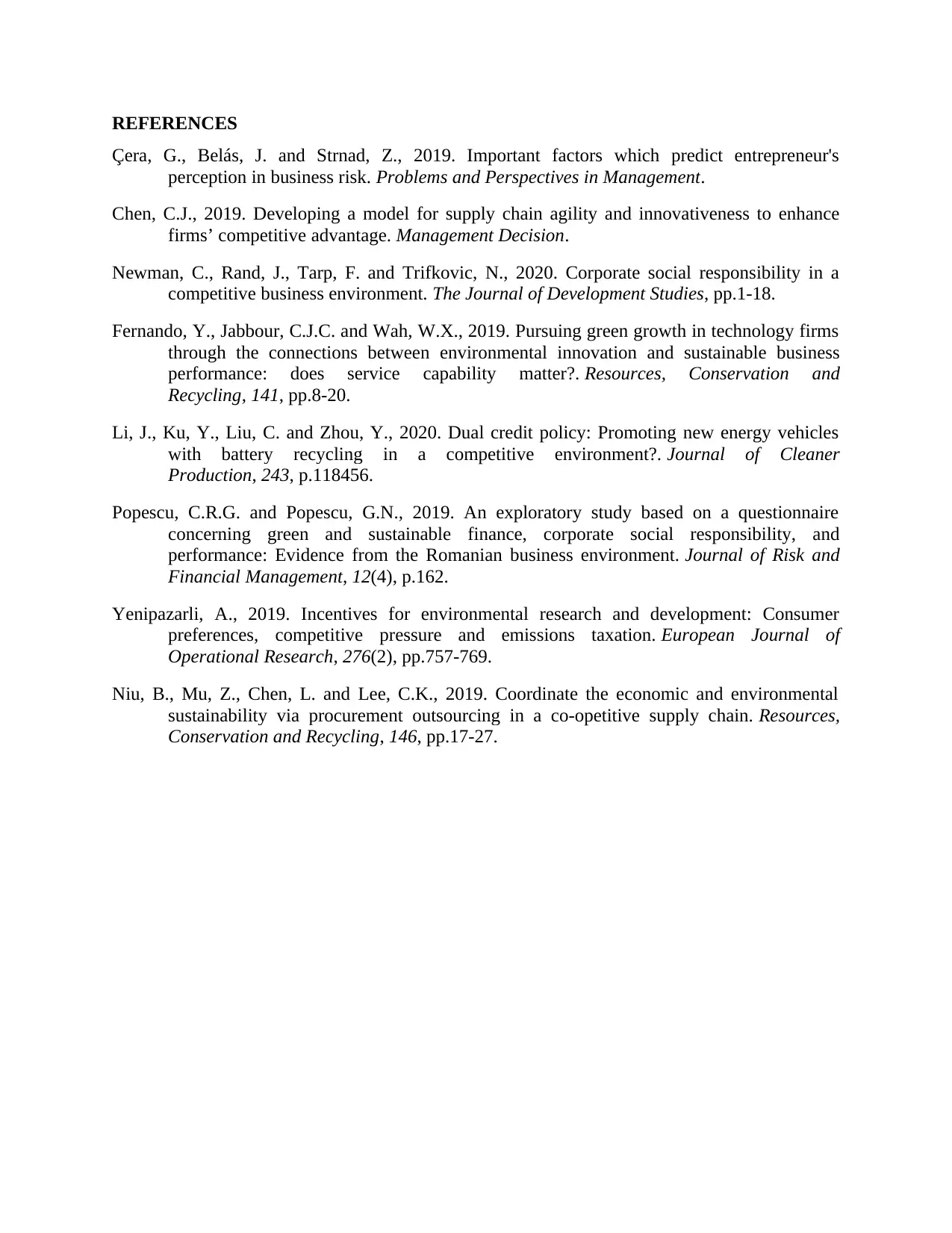
REFERENCES
Çera, G., Belás, J. and Strnad, Z., 2019. Important factors which predict entrepreneur's
perception in business risk. Problems and Perspectives in Management.
Chen, C.J., 2019. Developing a model for supply chain agility and innovativeness to enhance
firms’ competitive advantage. Management Decision.
Newman, C., Rand, J., Tarp, F. and Trifkovic, N., 2020. Corporate social responsibility in a
competitive business environment. The Journal of Development Studies, pp.1-18.
Fernando, Y., Jabbour, C.J.C. and Wah, W.X., 2019. Pursuing green growth in technology firms
through the connections between environmental innovation and sustainable business
performance: does service capability matter?. Resources, Conservation and
Recycling, 141, pp.8-20.
Li, J., Ku, Y., Liu, C. and Zhou, Y., 2020. Dual credit policy: Promoting new energy vehicles
with battery recycling in a competitive environment?. Journal of Cleaner
Production, 243, p.118456.
Popescu, C.R.G. and Popescu, G.N., 2019. An exploratory study based on a questionnaire
concerning green and sustainable finance, corporate social responsibility, and
performance: Evidence from the Romanian business environment. Journal of Risk and
Financial Management, 12(4), p.162.
Yenipazarli, A., 2019. Incentives for environmental research and development: Consumer
preferences, competitive pressure and emissions taxation. European Journal of
Operational Research, 276(2), pp.757-769.
Niu, B., Mu, Z., Chen, L. and Lee, C.K., 2019. Coordinate the economic and environmental
sustainability via procurement outsourcing in a co-opetitive supply chain. Resources,
Conservation and Recycling, 146, pp.17-27.
Çera, G., Belás, J. and Strnad, Z., 2019. Important factors which predict entrepreneur's
perception in business risk. Problems and Perspectives in Management.
Chen, C.J., 2019. Developing a model for supply chain agility and innovativeness to enhance
firms’ competitive advantage. Management Decision.
Newman, C., Rand, J., Tarp, F. and Trifkovic, N., 2020. Corporate social responsibility in a
competitive business environment. The Journal of Development Studies, pp.1-18.
Fernando, Y., Jabbour, C.J.C. and Wah, W.X., 2019. Pursuing green growth in technology firms
through the connections between environmental innovation and sustainable business
performance: does service capability matter?. Resources, Conservation and
Recycling, 141, pp.8-20.
Li, J., Ku, Y., Liu, C. and Zhou, Y., 2020. Dual credit policy: Promoting new energy vehicles
with battery recycling in a competitive environment?. Journal of Cleaner
Production, 243, p.118456.
Popescu, C.R.G. and Popescu, G.N., 2019. An exploratory study based on a questionnaire
concerning green and sustainable finance, corporate social responsibility, and
performance: Evidence from the Romanian business environment. Journal of Risk and
Financial Management, 12(4), p.162.
Yenipazarli, A., 2019. Incentives for environmental research and development: Consumer
preferences, competitive pressure and emissions taxation. European Journal of
Operational Research, 276(2), pp.757-769.
Niu, B., Mu, Z., Chen, L. and Lee, C.K., 2019. Coordinate the economic and environmental
sustainability via procurement outsourcing in a co-opetitive supply chain. Resources,
Conservation and Recycling, 146, pp.17-27.
⊘ This is a preview!⊘
Do you want full access?
Subscribe today to unlock all pages.

Trusted by 1+ million students worldwide

1 out of 10
Related Documents
Your All-in-One AI-Powered Toolkit for Academic Success.
+13062052269
info@desklib.com
Available 24*7 on WhatsApp / Email
![[object Object]](/_next/static/media/star-bottom.7253800d.svg)
Unlock your academic potential
Copyright © 2020–2025 A2Z Services. All Rights Reserved. Developed and managed by ZUCOL.





